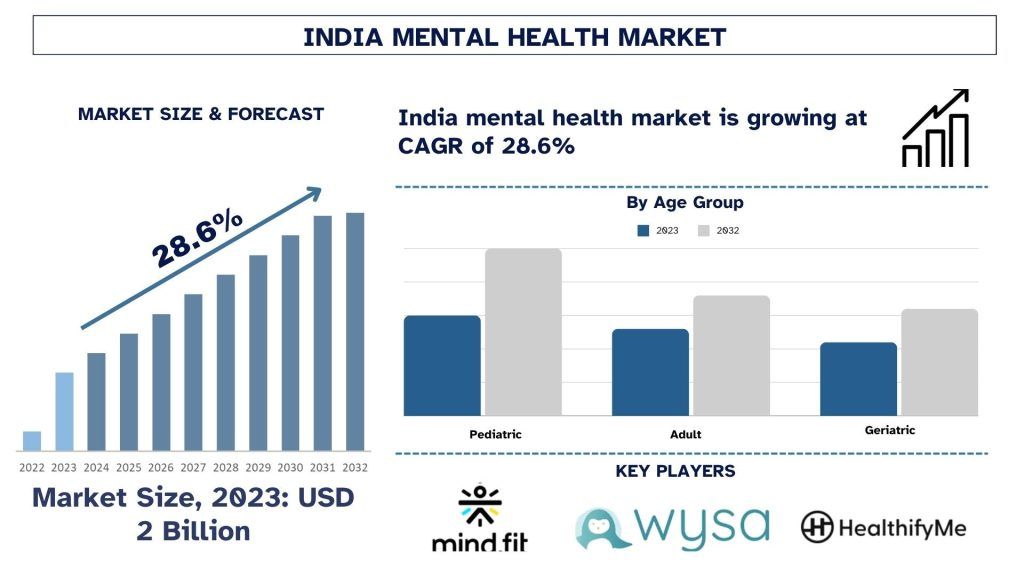- Home
- About Us
- Industry
- Services
- Reading
- Contact Us
India Mental Health Market: Current Analysis and Forecast (2024-2032)
Emphasis on Disorders (Substance Use Disorders, Schizophrenia And Other Psychotic Disorders, Mood Disorders, Neurotic And Stress-Related Disorders, And Suicidal Risk & Others.); Services (Emergency Mental Health Services, Outpatient Counseling, Home-Based Treatment Services, Inpatient Hospital Treatment Services, Other Services); Age Group (Pediatric, Adult, Geriatric); Region/Cities
India Mental Health Market Size & Forecast
The India Mental Health market was valued at approximately USD 2 Billion in 2023 and is expected to grow at a robust CAGR of around 28.6% during the forecast period (2024-2032) owing to the growing cases of mental health disorders, rising awareness about mental health, increasing company collaborations, and rising support from the government are driving the growth of the mental health market in India.
India Mental Health Market Analysis
Mental health includes our emotional, psychological, and social well-being. It affects how we think, feel, and act as we cope with life. Problems related to mental health are characterized by the absence of positive emotion, low mood, and a range of associated cognitive, physical, emotional, and behavioral symptoms. According to the WHO, the burden of mental health problems in India is 2443 disability-adjusted life years (DALYs) per 10,000 population; the age-adjusted suicide rate per 100,000 population is 21.1. This increase in the number of patients suffering from mental illnesses has created the need for quicker healthcare. Therefore, to address this issue, digital healthcare tools are offering the potential to scale up the treatment and decrease the cost of treatment for patients suffering from various mental illnesses, which in turn is leading to growth in the adoption of various mental health applications.
India Mental Health Market Trends
This section discusses the key market trends influencing the India Mental Health segments as identified by our research experts.
Depression Disorder Transforming Industry
Based on disorders, the mental health market is segmented into schizophrenia, alcohol use disorders, bipolar disorder, depression, anxiety, eating disorders, and other disorders. In 2023, the depression segment grabbed the major market share and is expected to maintain its dominance during the forecast period, owing to the increase in cases of depression in India. For instance, as per a survey previewed in the State of the World’s Children 2021, nearly 14% of 15 to 24-year-olds in India, or 1 in 7, reported often feeling depressed or having little interest in doing things.
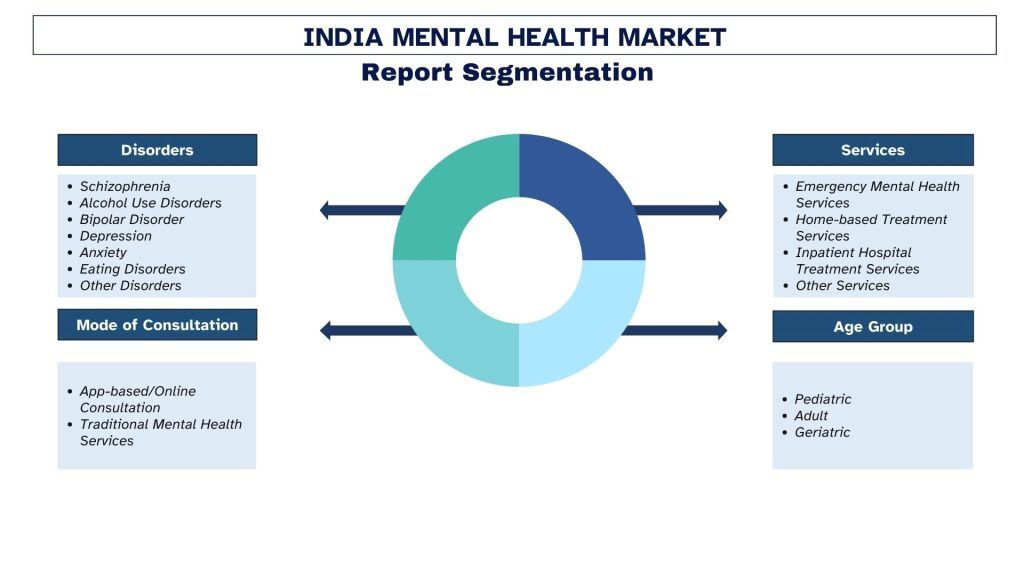
North India Dominated the Market in 2023
The demand of the mental health market in North India is due to the enhancement of clients’ awareness to mental health problems and services, and the decrease of mental health services. With increasing advanced levels of stress resulting from urbanization, economic factors as well as changes of lifestyle people have been forced to seek psychiatric and counseling services. This is through intervention from the government of India through legislation namely the Mental Healthcare Act, of 2017, and supportive policies for example the National Mental Health Programmes There is an additional emphasis on service delivery in this area through the utilization of digital technology, telemedicine and Apps on mental health to cover the rural areas. Moreover, the Corporate Wellness Programs are also helping in the improvement of the mental health of the public residing in various cities.
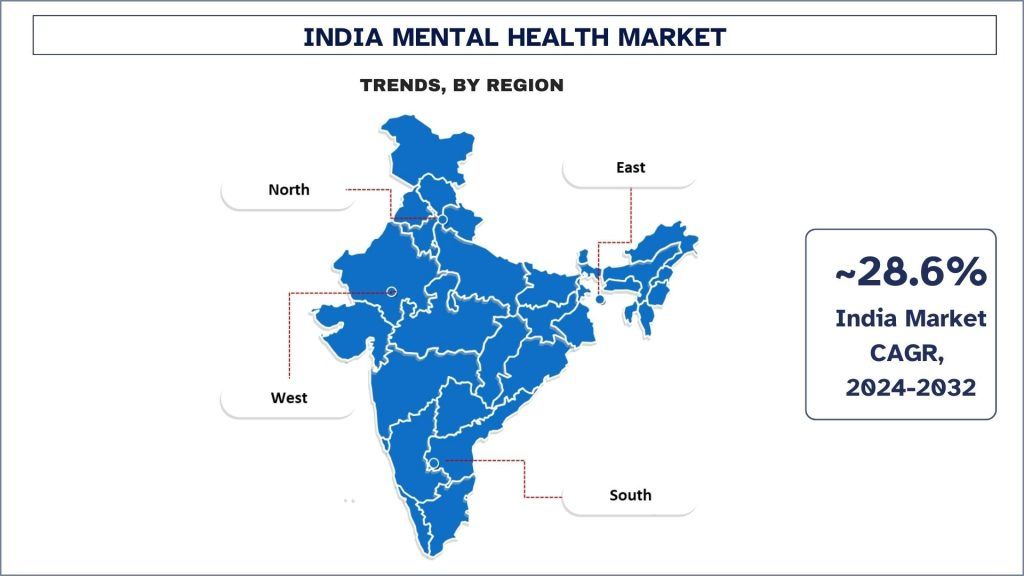
India Mental Health Industry Overview
India Mental Health is competitive, with several Indian and international market players. The key players are adopting different growth strategies to enhance their market presence, such as partnerships, agreements, collaborations, new product launches, geographical expansions, and mergers and acquisitions. Some of the major players operating in the market are Wysa Ltd, InnerHour , Snehi, YourDOST, EpsyClinic HealthCare Private Limited, The Banyan, HealthifyMe, Mindfit AS, iCALL Psychosocial Helpline (Tata Institute of Social Sciences) and Manastha Health Solutions Private Limited
India Mental Health Market News
- In February 2024, the Government of India merged KIRAN Mental Health, which has served over 1,27,390 callers since its establishment in September 2020 rehabilitation helpline, with TeleMANAS, the National Tele Mental Health Helpline.
- In April 2024, Wysa, an AI-driven mental health support provider, launched its conversational AI therapy app for mental health in Hindi, with the aim to enhance the accessibility of quality mental health services in underserved communities, particularly in Tier II and III cities across India.
India Mental Health Market Report Coverage
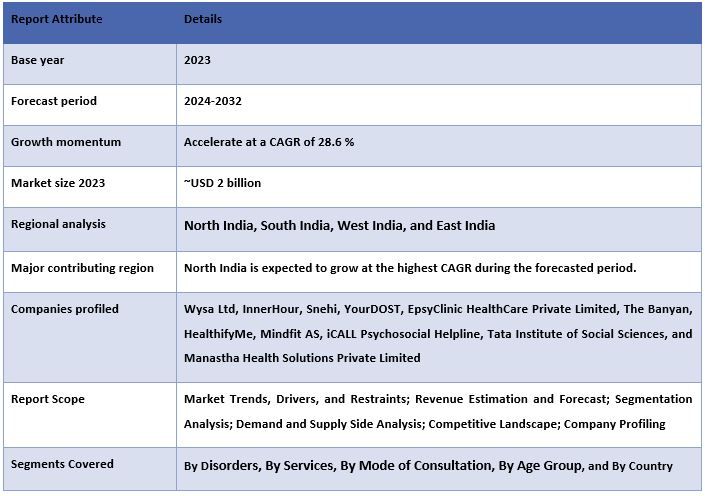
Reasons to buy this report:
- The study includes market sizing and forecasting analysis validated by authenticated key industry experts.
- The report presents a quick review of overall industry performance at one glance.
- The report covers an in-depth analysis of prominent industry peers with a primary focus on key business financials, product portfolios, expansion strategies, and recent developments.
- Detailed examination of drivers, restraints, key trends, and opportunities prevailing in the industry.
- The study comprehensively covers the market across different segments.
- Deep dive regional level analysis of the industry.
Customization Options:
India Mental Health can further be customized as per the requirement or any other market segment. Besides this, UMI understands that you may have your own business needs; hence, feel free to connect with us to get a report that completely suits your requirements.
Table of Content
Research Methodology for the India Mental Health Market Analysis (2022-2032)
Analyzing the historical market, estimating the current market, and forecasting the future market of the India Mental Health market were the three major steps undertaken to create and analyze the adoption of India Mental Health in major regions. Exhaustive secondary research was conducted to collect the historical market numbers and estimate the current market size. Secondly, numerous findings and assumptions were taken into consideration to validate these insights. Moreover, exhaustive primary interviews were also conducted, with industry experts across the value chain of the India Mental Health market. Post assumption and validation of market numbers through primary interviews, we employed a top-down/bottom-up approach to forecasting the complete market size. Thereafter, market breakdown and data triangulation methods were adopted to estimate and analyze the market size of segments and sub-segments of the industry. Detailed methodology is explained below:
Analysis of Historical Market Size
Step 1: In-Depth Study of Secondary Sources:
A detailed secondary study was conducted to obtain the historical market size of the India Mental Health market through company internal sources such as annual reports & financial statements, performance presentations, press releases, etc., and external sources including journals, news & articles, government publications, competitor publications, sector reports, third-party database, and other credible publications.
Step 2: Market Segmentation:
After obtaining the historical market size of India Mental Health, we conducted a detailed secondary analysis to gather historical market insights and share for different segments & sub-segments for major regions. Major segments are included in the report, such as disorders, services, mode of consultation, age group, and region. Further country-level analyses were conducted to evaluate the overall adoption of testing models in that region.
Step 3: Factor Analysis:
After acquiring the historical market size of different segments and sub-segments, we conducted a detailed factor analysis to estimate the current market size of the India Mental Health market. Further, we conducted factor analysis using dependent and independent variables such as disorders, services, mode of consultation, age group, and India Mental Health regions. A thorough analysis was conducted of demand and supply-side scenarios considering top partnerships, mergers and acquisitions, business expansion, and product launches in the India Mental Health market sector across the globe.
Current Market Size Estimate & Forecast
Current Market Sizing: Based on actionable insights from the above three steps, we arrived at the current market size, key players in the India Mental Health market, and market shares of the segments. All the required percentage shares split, and market breakdowns were determined using the above-mentioned secondary approach and were verified through primary interviews.
Estimation & Forecasting: For market estimation and forecast, weights were assigned to different factors including drivers & trends, restraints, and opportunities available for the stakeholders. After analyzing these factors, relevant forecasting techniques i.e., the top-down/bottom-up approach were applied to arrive at the market forecast for 2032 for different segments and sub-segments across the major markets. The research methodology adopted to estimate the market size encompasses:
- The industry’s market size, in terms of revenue (USD) and the adoption rate of the India Mental Health across the major markets domestically
- All percentage shares, splits, and breakdowns of market segments and sub-segments
- Key players in the India Mental Health in terms of products offered. Also, the growth strategies adopted by these players to compete in the fast-growing market
Market Size and Share Validation
Primary Research: In-depth interviews were conducted with the Key Opinion Leaders (KOLs), including Top Level Executives (CXO/VPs, Sales Head, Marketing Head, Operational Head, Regional Head, Country Head, etc.) across major regions. Primary research findings were then summarized, and statistical analysis was performed to prove the stated hypothesis. Inputs from primary research were consolidated with secondary findings, hence turning information into actionable insights.
Split of Primary Participants in Different Regions
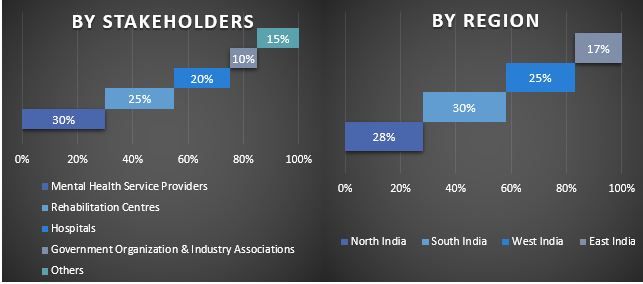
Market Engineering
The data triangulation technique was employed to complete the overall market estimation and to arrive at precise statistical numbers for each segment and sub-segment of the India Mental Health. Data was split into several segments and sub-segments after studying various parameters and trends in the disorders, services, mode of consultation, age group, and regions of the India Mental Health market.
The main objective of the India Mental Health Market Study
The current & future market trends of the India Mental Health were pinpointed in the study. Investors can gain strategic insights to base their discretion for investments on the qualitative and quantitative analysis performed in the study. Current and future market trends determined the overall attractiveness of the market at a regional level, providing a platform for the industrial participant to exploit the untapped market to benefit from a first-mover advantage. Other quantitative goals of the studies include:
- Analyze the current and forecast market size of the India Mental Health market in terms of value (USD). Also, analyze the current and forecast market size of different segments and sub-segments.
- Segments in the study include areas of disorders, services, mode of consultation, age group, and regions.
- Define and analyze the regulatory framework for the India Mental Health
- Analyze the value chain involved with the presence of various intermediaries, along with analyzing customer and competitor behaviors of the industry.
- Analyze the current and forecast market size of the India Mental Health market for the major regions.
- Major regions studied in the report include North India, West India, South India and East India
- Company profiles of the India Mental Health market and the growth strategies adopted by the market players to sustain in the fast-growing market.
- Deep dive regional level analysis of the industry
Frequently Asked Questions FAQs
Q1: What is India Mental Health current size and growth potential?
Q2: What are the driving factors for the growth of India Mental Health?
Q3: Which segment has the largest share of India Mental Health by Disorder?
Q4: What are the emerging technologies and trends in India Mental Health?
Q5: Which region will dominate the India Mental Health Market?
Related Reports
Customers who bought this item also bought

